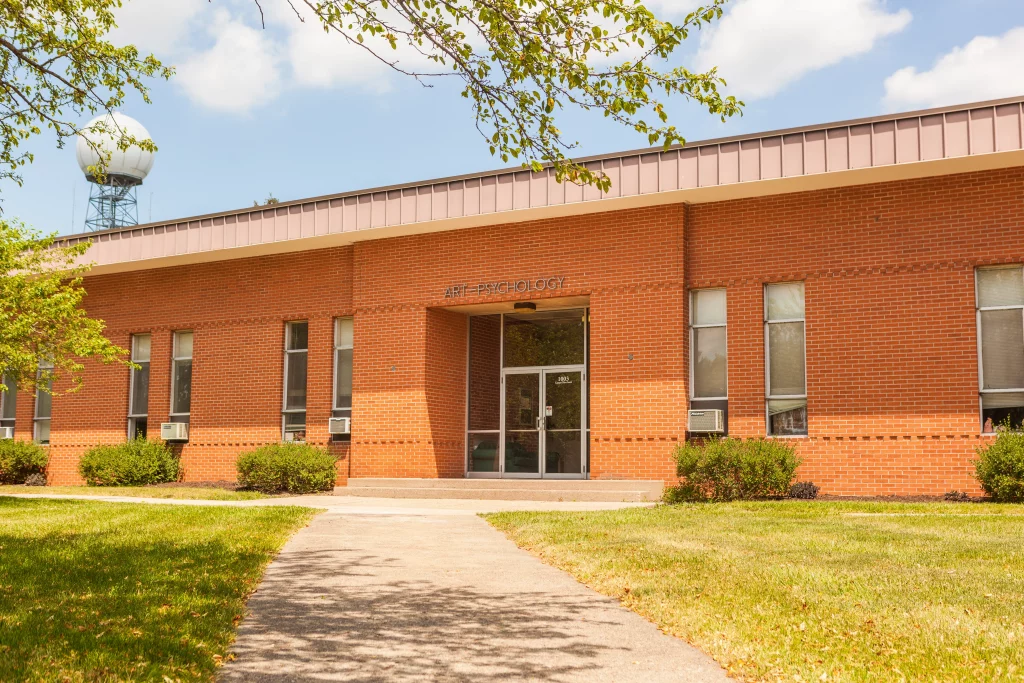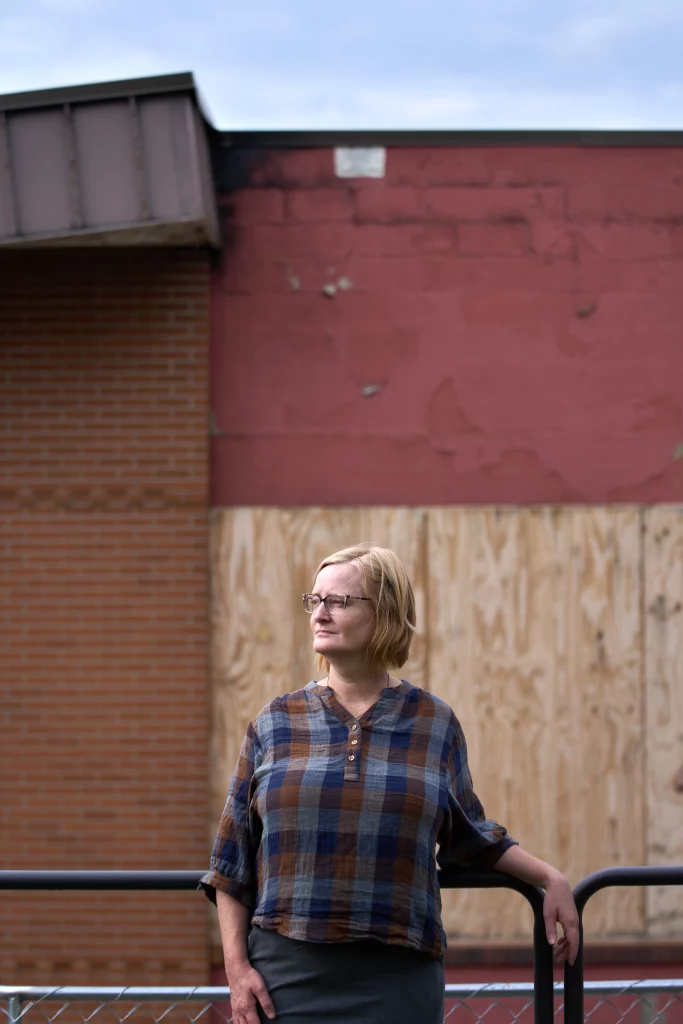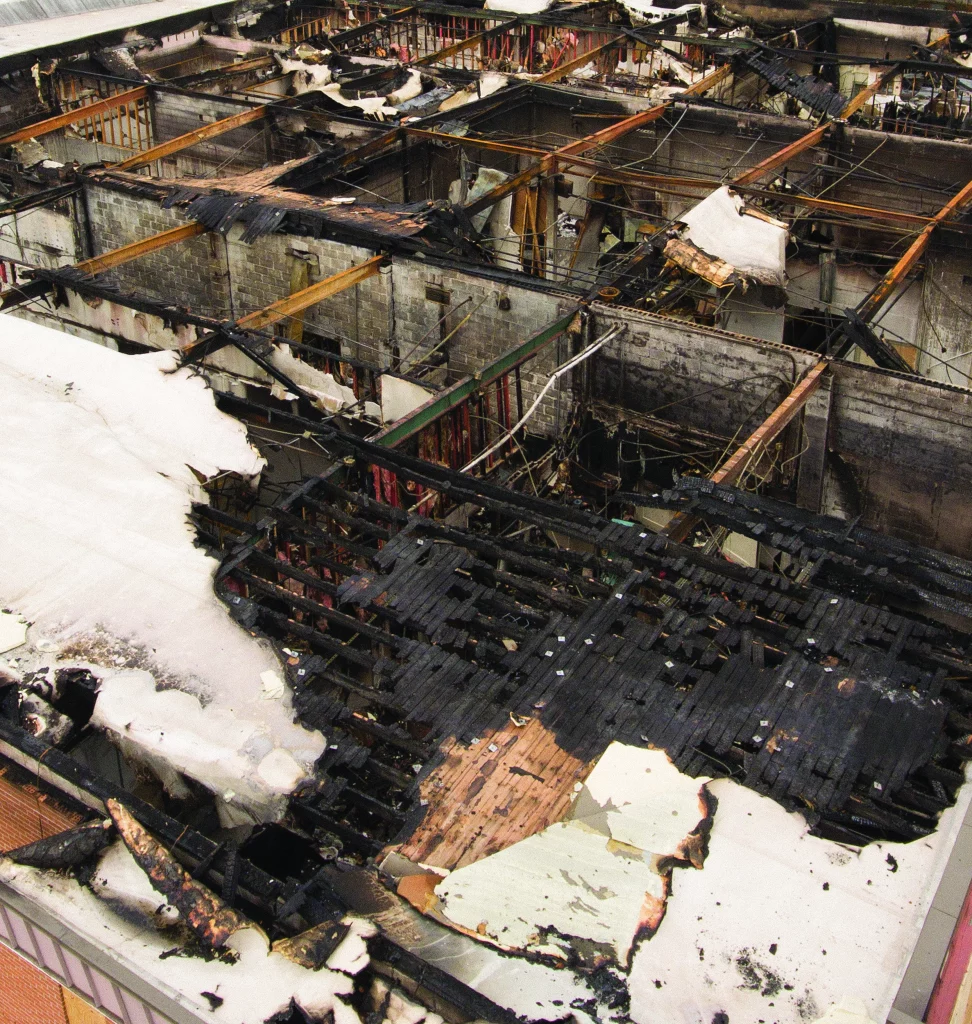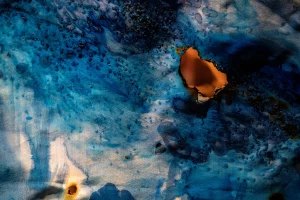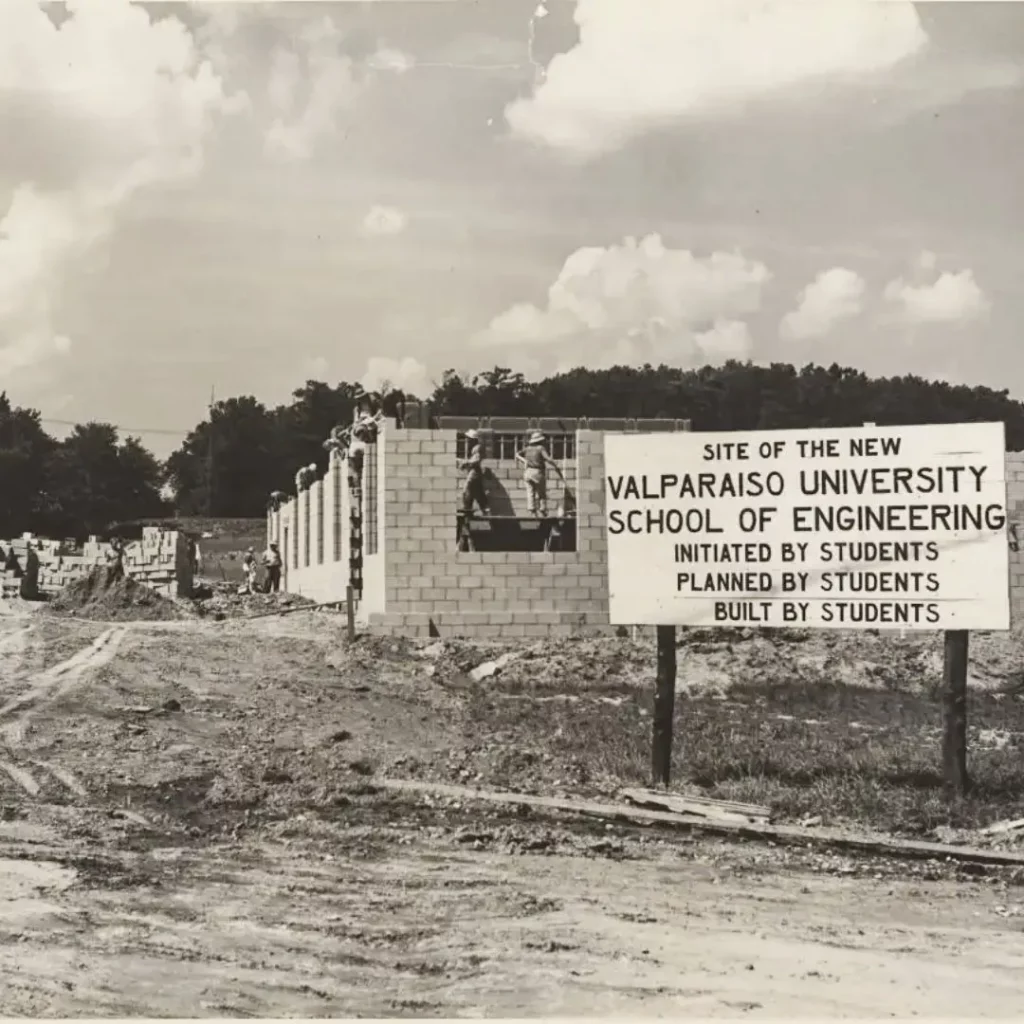As soon as I saw the smoke I thought… ‘that could be my building.
Sarah Jantzi, associate professor of communications and visual art
April 29, 2022, was set to be a special day for senior art students at Valparaiso University. Eleven of them would be graduating soon and were eager to show the culmination of their hard work to family, friends, faculty, and peers at the Senior Studio and Digital Art Thesis Exhibition Art Walk. The exhibition spanned the entire campus and showcased a variety of art styles including photography, paint, and a 5’ x 15’ tapestry. The tapestry, which dealt with the topic of loss, had been burned at the edges, a last-minute artistic choice that would serve as a predictor of the tragic event that was about to happen.
Sarah Jantzi, associate professor in the communications and visual arts department, was as busy as any of her students that day, preparing for the 5:30 p.m. reception and running food to the various points of the walk. She was just coming to campus with freshly made guacamole when she noticed the fire engines and the road to the Art-Psychology Building blocked off.
Professor Jantzi was interested in art from a young age and would pursue that interest into her college years, earning a B.A. from Indiana University in Bloomington in 1998 and her MFA from American University in 2002.
Her art has been exhibited in Indiana, Illinois, Ohio, Michigan, Kansas, New York, Pennsylvania, Maryland, Washington, D.C., and Italy. Her desire to teach at the college level came from her enjoyment in helping her fellow students, her enthusiasm for explaining the technical aspects of the field, and her desire to learn more about art and have meaningful conversations about it with other adults.
Coming to Valparaiso University was, in large part, a matter of pure chance. After graduating from Indiana University, Professor Jantzi taught at a number of schools on the East Coast, and moving to Northwest Indiana was not on her radar. She recalls that while contemplating where she should go next, a Valparaiso University pamphlet happened to be sitting nearby.
Professor Jantzi had a family connection to the Art – Psychology Building well before it became her workplace. A generation before, Professor Jantzi’s father had spent his own undergraduate years there as he earned his bachelor of science in civil engineering in 1968. Remembering her father’s alma mater, she decided to pursue a position in what is now the communication and visual arts department in 2004, and has been teaching at the University ever since.
“It just fits like a glove,” Professor Jantzi says.
Eighteen years later, on the day of the senior exhibition art walk, Professor Jantzi quickly realized why the fire department was out in force.
“As soon as I saw the smoke I thought ‘that could be my building’,” Professor Jantzi says. “Then I realized it was the painting studio, and I thought to myself ‘they’re going to put this out,’ even though the smoke was coming through the roof at that point.”
Do we spend our night just staring at this, or do we move forward and do what we’re here to do?
HISTORY IN A BUILDING
The Art-Psychology Building held a special significance on campus. After WWII, Valpo students took it upon themselves to raise the funds for a new engineering laboratory space with the idea of bringing the four-year engineering program back to the school. They succeeded, constructing the building with their own hands, and engineering programs were hosted in the building from its dedication in 1949 to the opening of the Gellersen Engineering and Mathematics Center in 1968.
After a fire at Kinsey Hall in 1970, the building became the home of the art and music programs. The music programs would depart for the Center for the Arts in 1995, while art students still called the building home.
A TRAGIC AFTERMATH
Hopes that the fire could be contained and the building saved were quickly quashed as the flames began to crawl across the rest of the building. Professor Jantzi’s first and foremost concern was making sure that everyone was safe.
“A lot of my seniors had spent a lot of time in that building recently, and I had one student worker,” Professor Jantzi recalls. “I wanted to make sure they were all okay.”
Thankfully, there were no injuries from the fire, but now Professor Jantzi had another problem. Her senior students, dressed up for the occasion and many with their parents, were now standing with her around the building, wondering what they should do next.
“Do we spend our night just staring at this, or do we move forward and do what we’re here to do?” Professor Jantzi summarizes. “At some point, I decided we were going to continue the show. I don’t know if that was the right decision, but I think that was important to the seniors.”
As the fire finally subsided and damage assessment went underway, it was not long before the building was declared a total loss. More than the structure itself, countless hours of work were consumed by the fire. Drawing projects, entire portfolios of work, and huge quantities of art supplies were now completely gone. For Professor Jantzi, more than 15 years of work, including everything from graduate school, was destroyed in the fire.
“All of my old work was there, a lot of my supplies, and all of my teaching supplies and books,” Professor Jantzi says. “Everything was in the building.”
REMEMBERING AND MOVING FORWARD
The loss of a building with so much work and memory has been a major blow to all the students, faculty, and staff who worked in the Art-Psychology Building. For Professor Jantzi, the emotional difficulty of the tragedy, especially close on the heels of losing her father earlier in 2022, was intense.
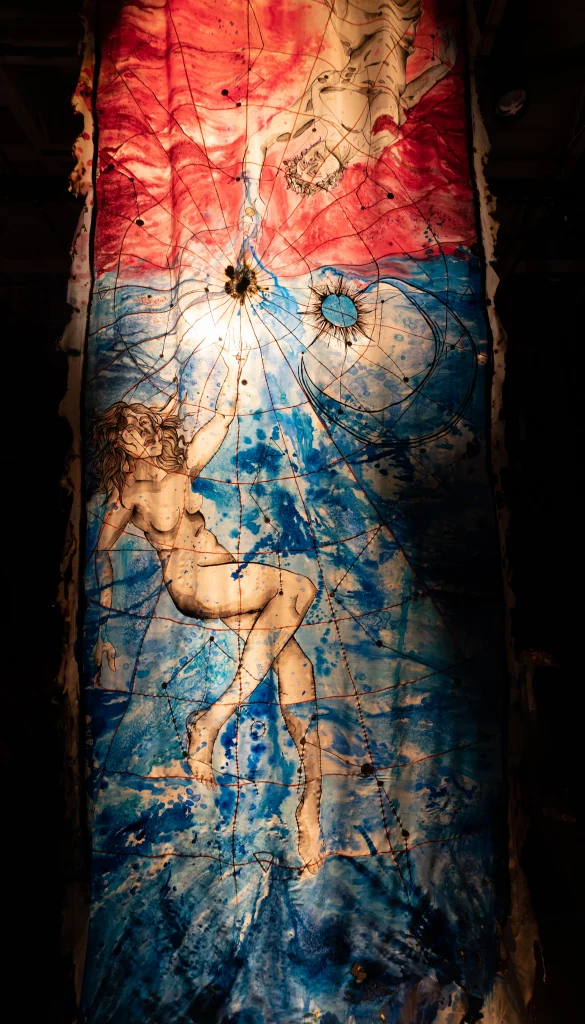
“It was a different kind of dynamic,” Professor Jantzi recalls. “That building was never the prettiest, but it was always a building where we could make a mess, be ourselves, and put the music on as loud as we wanted. There was something homey about the fact there was a mixture of old and new, and that students didn’t have to worry about the floors getting dirty.”
More than the loss of the building was the loss of what the structure represented. For Professor Jantzi, learning and teaching in the field of art is much more than simple instruction and study, but an intimate experience where professors and students learn about each other and themselves. Those experiences were embedded in the very walls.
“So many memories. Every hole from a push-pin on the wall, every piece of tape on the floor. I think about how many students have gone through that building,” Professor Jantzi says. “I think when you’re going through teaching art, you’re going through the mechanics of shading and lighting, but you’re also trying to listen to what your students are seeing and reacting to. There’s a lot of conversations about everything from home to spirituality that you work to identify.”
In the immediate aftermath of the fire, Abbey Houx ’11 Bodine ’17 M.S. recalls how Professor Jantzi continued to care for her students while still creating art.
“After the memorial service, I brought her a big chunk of charcoal I found outside the fence,” Abbey says. “And when she’s ready, maybe she’d like to make something with it. She turned and said ‘yeah? I’m ready now. Everybody grab a piece and let’s sign the sidewalk.’ She kept asking the current art students how they were doing, taking care of others.”
In the days and weeks following the fire, Professor Jantzi was able to hold her regularly scheduled class in unused labs in the chemistry department for what little time remained in the semester. She herself bought supplies, including papers, pencils, and clipboards, to ensure that even those who had suffered immense loss still had a place to participate in art.
“My senior class had some students who were deeply affected,” Professor Jantzi says. “We all talked about the fire. There were some good conversations.”
One of those conversations centered on the intentionally burned tapestry project, which had been removed from the Art-Psychology Building the day before the fire to be installed in the Black Box Theatre.
“The piece took on a whole new meaning, as did a few other pieces,” Professor Jantzi says. “We discovered how that process of art can change with people. You intend for your work to mean one thing, and then something happens and the meaning of the piece changes.”
Ultimately, while the loss of a beloved space for creativity and connection has been intensely mourned, Professor Jantzi says that the truly important ideas the building represented had nothing to do with the structure itself, or even the artwork that was lost in the blaze.
“The things we did in that building and the work that we lost weren’t the important things,” Professor Jantzi says. “The important things were what they learned moving forward, their experiences. The students are the art. They are the thing that will matter in the end.”
AN EXTRAORDINARY EXISTENCE
The Art-Psychology Building at Valparaiso University has one of the most storied histories on campus, having touched a multitude of students, faculty members, and departments across campus.
1949
The new engineering building, designed and built by students in the aftermath of WWII, is dedicated. The new space allows the four-year program to return to campus.
1968
The Gellersen Engineering and Mathematics Center opens, taking over duties as the primary engineering space on campus.
1970
A fire at Kinsey Hall leaves the art and music programs at the University without a home. The recently vacated areas of the former engineering building are selected as their new home.
1995
The Center for the Arts opens, giving the music program a more suitable space to work in, and leaving the remainder of the building for Valpo’s art and psychology programs.
2022
A fire at the Art-Psychology Building renders the space unusable. While many pieces are saved by facility management and the Valparaiso University Police Department, the majority of the projects inside are destroyed.

